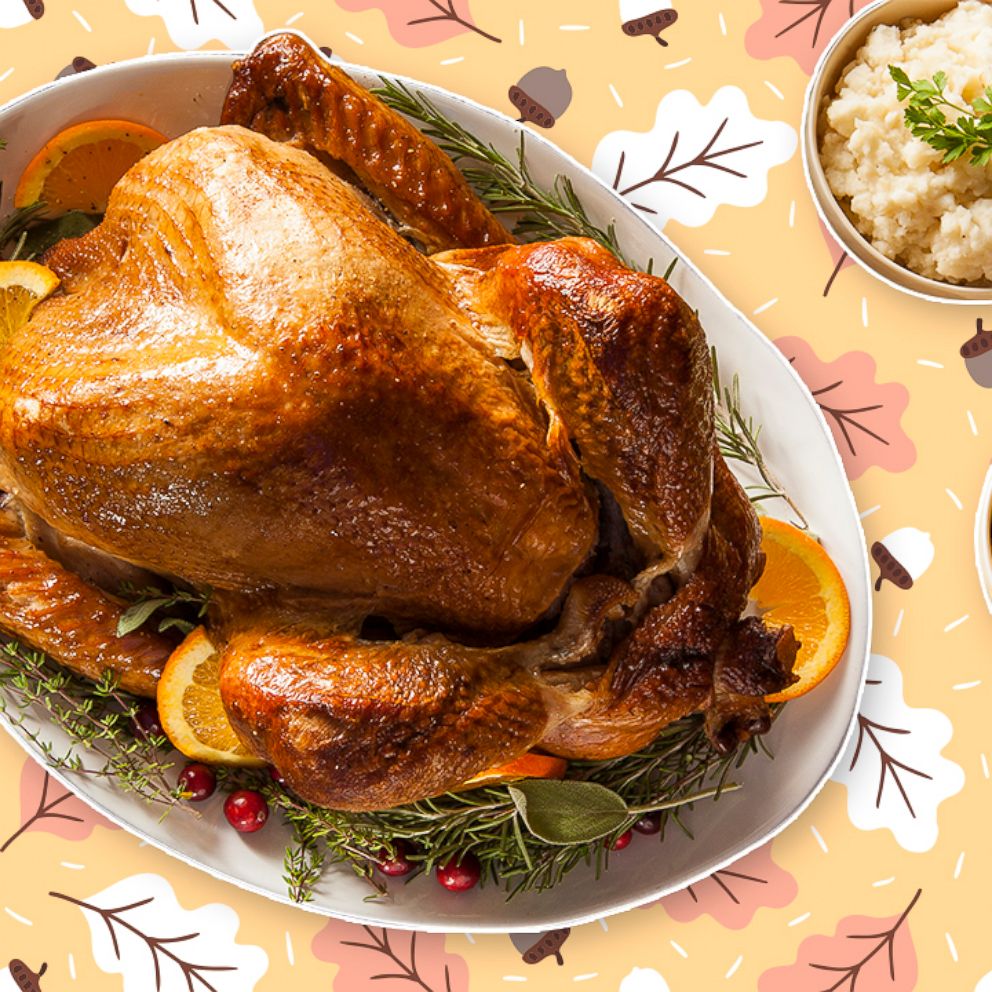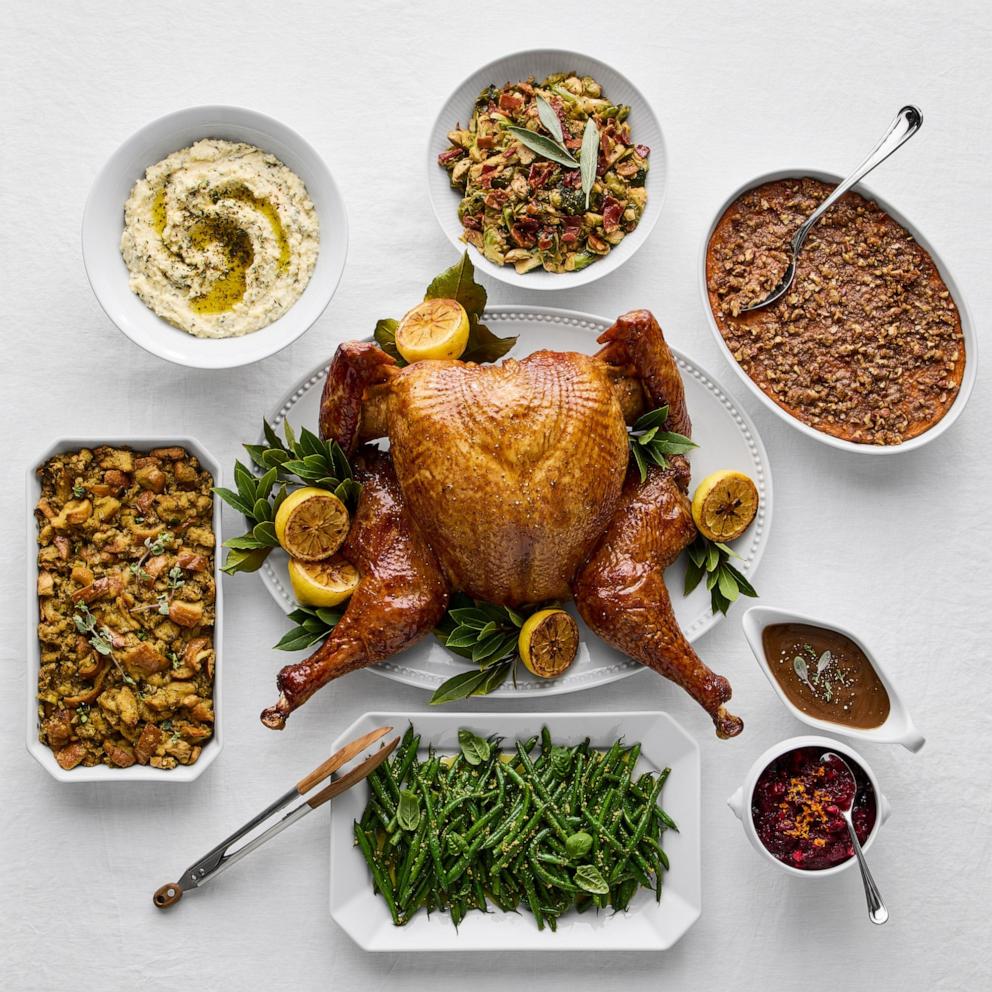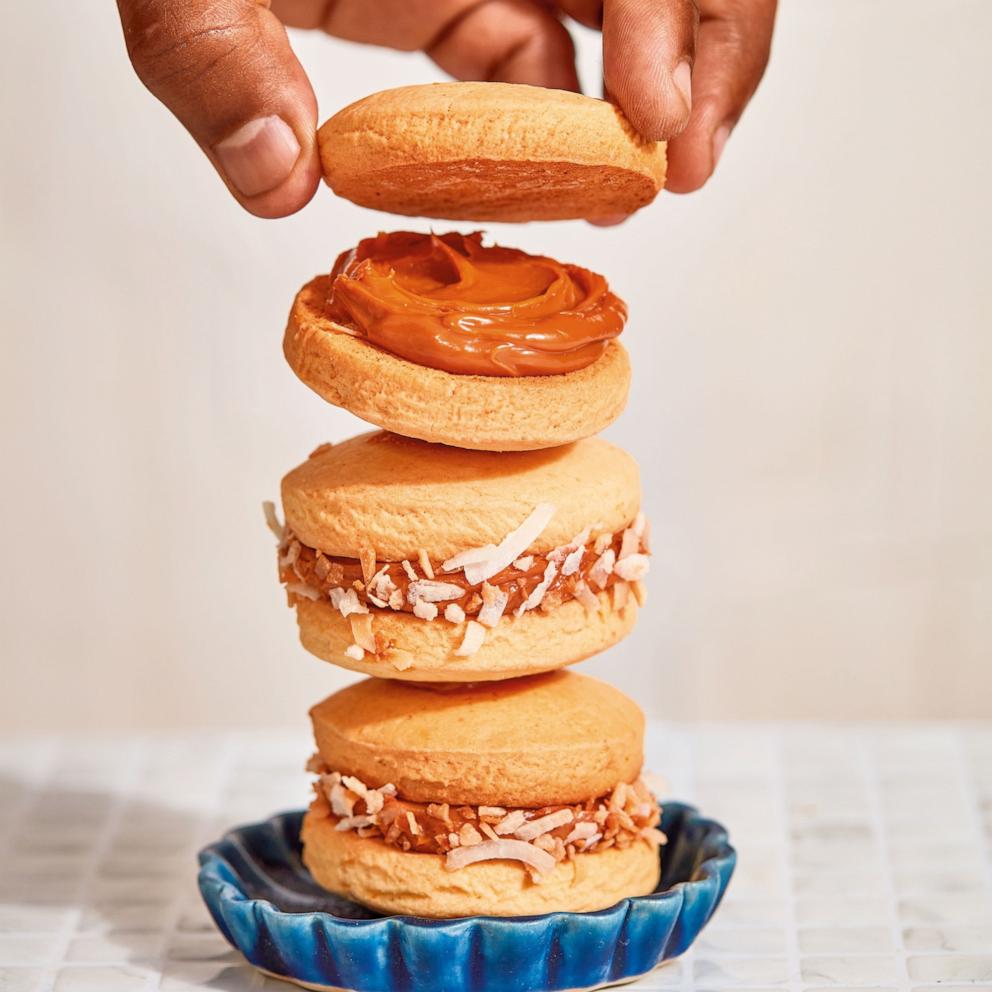'Savory Baking' recipes to make this fall

'Tis the season for baking and this fall is the perfect time to introduce more savory recipes to the mix.
Bestselling author, recipe developer, food stylist and web series host Erin Jeanne McDowell joined "Good Morning America" to share recipes and tips from her highly anticipated new cookbook, "Savory Baking: Recipes for Breakfast, Dinner, and Everything in Between."
The beloved baker, who is a regular contributor to New York Times Cooking, Food52, and Food Network Kitchen, includes options for multiple kinds of fresh baked good that can be whipped up whenever the mood strikes.
In her mouthwatering guide, which is the next best thing to a private baking and pastry class, McDowell lends her signature fun and reassuring style to these inventive dishes, plus offers variations for endless customizations.

Check out a handful of quick breads, muffins, pie crust alternatives and more, reprinted from McDowell's new book below.
Pine Nut and Salami Quick Bread
Makes one 9 x 5-inch loaf
A reliable quick bread recipe is a perfect back-pocket bake. Omit the pine nuts and diced salami, and you've got a perfect base recipe to tweak or dress up however you like. Check out the first two variations below, both inspired by charcuterie board snacking. Depending on the saltiness of the inclusions you add, you may want to adjust the amount of salt in the dough, particularly for the olive and feta version; you may need the lower amount of salt because of the brininess of both inclusions. This bread keeps well for several days, but thin slices can also be toasted for tasty makeshift crackers.

Ingredients
300 grams (2 1/2 cups) all-purpose flour
10 grams (2 teaspoons) baking powder
4-6 grams (1-1 1/2 teaspoons) fine sea salt
3 grams (1 teaspoon) freshly ground black pepper
2 grams (about 1/2 teaspoon) chopped fresh thyme
45 grams (3 tablespoons) vegetable oil
28 grams (1 ounce or 2 tablespoons) unsalted butter, melted
2 large eggs, at room temperature
383 grams (1 1/4 cups) plain yogurt
113 grams (4 ounces) hard salami, finely diced
70 grams (1/2 cup) pine nuts, toasted and cooled
100 grams (1 cup) shredded Manchego cheese
Directions
Preheat the oven to 375 F/190 C with a rack in the center. Lightly grease a 9 x 5-inch / 23 x 13-centimeter loaf pan with nonstick spray.
In a medium bowl, whisk the flour, baking powder, salt, pepper, and thyme to combine.
In a large bowl, whisk the oil, melted butter, eggs, and yogurt together. Add the dry ingredients and mix with a spatula until the batter comes together.
Gently fold in the salami, pine nuts, and cheese until thoroughly incorporated. Spoon the batter into the prepared loaf pan and spread into an even layer.
Bake until a skewer inserted into the center of the loaf comes out clean or with just a few moist crumbs clinging to it, 40 to 45 minutes. Cool for 10 minutes in the pan, then unmold onto a cooling rack and let cool completely.
Variations
Marinated olive and feta quick bread: Omit the salami, pine nuts, and Manchego and fold 225 grams (1 1/4 cups) coarsely chopped pitted brine-cured olives, 175 grams (1 1/4 cups) crumbled feta cheese, 13 grams (1/3 cup) chopped fresh parsley, and 6 grams (2 tablespoons) minced fresh dill into the batter in step 4.
Ham and cheese quick bread: Omit the salami, pine nuts, and Manchego and fold 190 grams (1 heaping cup) diced ham and 150 grams (1 1/2 cups) shredded Gruyère cheese into the batter in step 4. Top the loaf with an additional 25 g / 1/4 cup grated cheese before baking. Increase the baking time to 50 to 55 minutes.
Everything kale quick bread: Before you make the batter, combine 113 grams (4 ounces) cream cheese, at room temperature, 1 large egg, and 50 grams (1/2 cup) thinly sliced scallions in a medium bowl and mix well. Omit the fresh thyme and stir 9 grams (1 tablespoon) white sesame seeds, 9 grams (1 tablespoon) black sesame seeds, 9 grams (1 tablespoon) poppy seeds, 9 grams (1 tablespoon) dried minced garlic, and 9 grams (1 tablespoon) dried minced onion into the flour mixture in step 2. Omit the salami, pine nuts, and Manchego and fold 76 grams (1 packed cup) shredded kale into the batter in step 4. Pour half of the batter into the pan and spread into an even layer. Dollop the cream cheese mixture on top and gently spread into an even layer, then pour the remaining batter on top. Sprinkle the surface of the loaf generously with "Everything" topping. Add 5 to 8 minutes to the bake time.
Make ahead and storage
This bread keeps well, wrapped tightly, at room temperature for up to 4 days (it makes great toast, but be careful, as some inclusions have a tendency to burn).
Muffins are just small quick breads
Can you bake one of these quickbread batters as muffins? Totally -- just look for the same visual cues for doneness and expect a significantly shorter bake time.
Can you bake most muffin batters as quickbreads? Absolutely, but in most cases, you should reduce the oven temperature by 25 degrees. Many muffin recipes are baked at a somewhat higher temperature to encourage nicely risen/domed muffins, but a loaf could get too dark and overly crusty by the time it bakes through at that higher temperature.
Quick and Easy Savory Muffins
Corn Muffins

Makes 12 muffins
Ingredients
"I'm crazy for cornbread, but I may love corn muffins even more. These muffins are just sweet enough, with a beautiful buttery flavor. They are not those huge bakery-style muffins, but a perfect homemade muffin size. They can be stuffed with cheese for a savory twist, and the batter can also be baked as a quick bread (see the Variations)."
142 grams (5 ounces/10 tablespoons) unsalted butter, melted
45 grams (3 tablespoons) neutral oil, such as canola or vegetable
106 grams (1/2 packed cup) light brown sugar
85 grams (1/4 cup) honey
1 large egg, at room temperature
173 grams (1 1/4 cups) yellow cornmeal
150 grams (1 1/4) cups all-purpose flour
16 grams (4 teaspoons) baking powder
3 grams (1/2 teaspoon) baking soda
6 grams (1 1/2 teaspoons) fine sea salt230 grams (1 cup) buttermilk, at room temperature
125 grams (3/4 cup) corn kernels (optional; drained well if canned, thawed if frozen)
Directions
Preheat the oven to 400 F with a rack in the center. Lightly grease the cavities of a muffin pan or line with muffin liners.
In a medium bowl, whisk the melted butter and oil together. Add the brown sugar and honey, whisking to combine. Add the egg and whisk well to combine.
In another medium bowl, whisk the cornmeal, flour, baking powder, baking soda, and salt until well combined. Add half of this mixture to the butter/oil and mix with a spatula to combine. Add half of the buttermilk, mixing to incorporate. Add the remaining flour mixture and then the remaining buttermilk, mixing just until uniformly combined. Fold in the corn kernels, if using.
Divide the batter evenly among the cavities of the prepared pan, filling each one to just under the rim. Bake for 5 minutes, then lower the oven temperature to 375 F (190 C) and bake for 18 to 22 minutes more, until the edges of the muffins are golden brown and a toothpick inserted into the center of one comes out clean or with a few moist crumbs clinging to it.
Let cool for at least 10 minutes before serving warm, or cool completely and serve at room temperature.
Variations
Cheese stuffed corn muffins: Omit the honey and reduce the brown sugar to 53 grams (1/4 packed cup). Scoop about half the batter into the pan, filling each cavity about half full. Press a 1-inch (2 1/2-centimeter) cube of cheddar cheese into the center of each muffin cup (you'll need about 285 grams or 10 ounces of cheese total), then use the remaining batter to cover the cheese completely. Bake as directed.
Corn muffin-style quickbread: Lightly grease a 9 x 5-inch (23 x 13-centimeter) loaf pan with nonstick spray. Reduce the baking powder to 12 grams (1 tablespoon). Prepare the batter as directed and pour into the prepared pan. Bake at 375 F (190 C) until a toothpick inserted into the center comes out clean, 55 minutes to 1 hour. Cool in the pan for 15 minutes, then unmold onto a wire rack to cool completely.
Sweet-tooth break
Add a glaze: A glaze is a quick and easy way to sweeten up a pastry that's bordering on dessert, like muffins, scones, brioche, or yeasted puff pastry. My basic ratio for glazes is: 1 1/4 cups powdered sugar + 1/4 cup-1/3 cup liquid.
The amount of liquid depends on how thick you want the glaze. The lesser amount will make a firmer, spreadable icing; the larger amount will result in a looser, pourable glaze. The liquid can be just about anything that lends itself to sweet treats! Some of my standbys include: Milk, milk substitute, half-and-half, or heavy cream (cream makes a rich glaze that's almost frosting-like).
Fruit puree: I make my own fruit purees using about 500 grams (3 cups) prepared fresh or frozen fruit and 50 grams (1/4 cup) granulated sugar: Combine in a large saucepan and cook over medium heat, stirring frequently, until the fruit breaks down, 8 to 10 minutes. Use a large fork or potato masher to coarsely mash the fruit, then strain the puree through a sieve. The fruit remaining in the sieve is great mixed into cocktails or used as low-sugar jam.
French Onion Muffins
Makes 12 muffins
These savory muffins were inspired by the classic gooey-cheese-topped soup. Caramelized onions and herbs flavor the batter, and a cheesy streusel caps them off. If you want to make these truly decadent, add a cube of Gruyère to each muffin before baking to give them a gooey, molten center.
Ingredients
Caramelized onions
28 grams (1 ounce or 2 tablespoons) unsalted butter
2 medium sweet onions, halved and sliced
2 grams (1/2 teaspoon) kosher salt
Freshly ground black pepper
45 grams (3 tablespoons) sherry
7 grams (1 1/2 teaspoons) beef bouillon base (such as Better Than Bouillon)2 cloves garlic, minced
Topping
60 grams (1/2 cup) all-purpose flour
40 grams (1/3 cup) whole wheat flour
Pinch of fine sea salt
85 grams (3 ounces or 6 tablespoons) cold unsalted butter, cut into 1/2-inch (1-centimeter) cubes
100 grams (1 cup) shredded Gruyère cheese
Batter
43 grams (1 1/2 ounces or 3 tablespoons) unsalted butter, melted
45 grams (3 tablespoons) neutral oil, such as canola or vegetable
2 large eggs
270 grams (2 1/4 cups) all-purpose flour
10 grams (2 teaspoons) baking powder
2 grams (1/2 teaspoon) fine sea salt
2 grams (1/2 teaspoon) freshly ground black pepper
3 grams (3/4 teaspoon) fresh chopped fresh thyme
230 grams (1 cup) buttermilk
78 grams (1/3 cup) heavy cream
100 grams (1 packed cup) shredded Gruyère cheese
About 180 grams (twelve 1/2-inch or 1-centimeter cubes) Gruyère cheese (optional)
Directions
Make the caramelized onions: In a large saute pan, melt the butter over medium heat. Add the onions and cook over medium heat until they begin to soften, 4 to 5 minutes. Season with the salt and pepper, lower the heat, and cook, stirring occasionally, until the onions are deeply caramelized, 30 to 35 minutes.
In a small bowl, whisk the sherry and bouillon base to combine. Set aside.
Add the garlic to the onions in the saute pan and cook until fragrant, 30 seconds to 1 minute. Add the sherry mixture and cook, stirring constantly, to deglaze the pan, then continue to cook until the liquid is mostly evaporated. Remove from the heat and let cool.
Make the topping: In a medium bowl, stir together the all-purpose flour, whole wheat flour, and salt. Add the butter and rub it into the flour using your hands or a pastry cutter until a crumbly mixture forms. Add the shredded cheese and toss well to combine.
Make the muffins: Preheat the oven to 400°F/205°C with a rack in the center. Lightly grease the cavities of a muffin pan with nonstick spray.
In a medium bowl, whisk the melted butter and vegetable oil together. Add the eggs one at a time, whisking to fully incorporate each one.
In a medium bowl, whisk the flour, baking powder, salt, black pepper, and thyme together. Add half of the flour to the butter/oil mixture and mix with a spatula to combine. Add the buttermilk and mix to combine. Add the remaining dry ingredients, then add the cream, mixing to combine. Gently fold in the cooled onion mixture and the shredded cheese.
Using a 1/4 cup, scoop the batter into the prepared pan, filling each cavity just over three-quarters full. If using the cheese cubes, fill each cavity halfway full, press a cube of cheese into the center of the batter, and then spoon the remaining batter over the cheese to cover it. Scatter the topping evenly over the muffins.
Bake until a toothpick inserted into the center of a muffin comes out clean, 24-30 minutes. Let cool for 10 minutes in the pan, then remove to a wire rack and serve warm.
Florentine Muffins
Light and fluffy with perfectly domed tops, these are everything a muffin should be. While this particular version is one of my favorites, think of it as a true base muffin batter. You can sub whatever other inclusions you want for the sautéed spinach and cheese. Most of my favorite variations (see below) are inspired by traditional breakfast combinations, like a classic quiche or a Western omelet. (Sautéing any ingredients that are high in moisture before adding them to the batter helps keep the texture of the muffin light and fluffy.) The sugar in the batter is optional, but it helps to keep the muffins soft.
Ingredients
Buttery, garlicky spinach
28 grams (1 ounce or 2 tablespoons) unsalted butter
2 cloves garlic, minced
180 grams (6 packed cups) spinach
Batter
43 grams (1 1/2 ounces or 3 tablespoons) unsalted butter, melted
45 grams (3 tablespoons) neutral oil, such as canola or vegetable
37 grams (3 tablespoons) granulated sugar (optional)2 large eggs
270 grams (2 1/4 cups) all-purpose flour
16 grams (2 tablespoons) cornmeal
10 grams (2 teaspoons) baking powder
2 grams (1/2 teaspoon) fine sea salt
385 grams (1 2/3 cups) buttermilk
170 grams (1 3/4 packed cups) shredded Gruyère or other Swiss cheese
Directions
Make the spinach: In a large sauté pan, melt the butter over medium heat. Add the garlic and cook until fragrant, 30 seconds to 1 minute. Add the spinach a few handfuls at a time and cook, stirring, until it's fully wilted, 2 to 3 minutes. Set aside to cool completely.
Make the muffins: Preheat the oven to 400 F (205 C) with a rack in the center. Lightly grease the cavities of a muffin pan with nonstick spray and spray the top of the pan as well; or use muffin liners and lightly grease both the liners and the top of the pan.
In a medium bowl, whisk the melted butter, oil, and sugar, if using, to combine. Add the eggs one at a time, whisking well to fully incorporate each one.
In a small bowl, whisk the flour, cornmeal, baking powder, and salt together. Add half of the flour to the butter/oil mixture and mix with a spatula to combine. Add half of the buttermilk and mix to combine. Repeat with the remaining dry ingredients and then the wet ingredients.
Gently fold in the cooled spinach mixture and 113 grams (1 cup) of the cheese. Using a 1/4 cup, scoop the batter into the prepared pan, filling each cavity just over three-quarters full. Top each muffin with 7 grams (1 tablespoon) of the remaining cheese.
Bake until a toothpick inserted into the center of a muffin comes out clean, 15 to 18 minutes. Let cool for 10 minutes in the pan, then remove to a wire rack to cool completely.
Variations
Lorraine Muffins: Omit the spinach filling and prepare the following mixture: In a medium skillet, cook 226 grams (8 ounces) thick-cut bacon, diced, over medium heat until the fat renders and the bacon is very crisp, 4-6 minutes. Use a slotted spoon to transfer the bacon to a small bowl. Add 1 medium sweet onion, thinly sliced, to the pan and cook until starting to become tender, 4-5 minutes. Transfer the onions to the bowl with the bacon and toss to combine. let cool for at least 15 minutes, then fold into the batter in step 5, along with the Gruyère and 30 grams (1/3 cup) grated Parmesan cheese.
Western Muffins: Replace the Gruyère with cheddar or Monterey Jack. Omit the spinach filling and prepare the following mixture: In a medium sauté pan, melt 28 grams (1 ounce or 2 tablespoons) unsalted butter over medium heat. Add 1/2 medium sweet onion, diced, and 1/2 large bell pepper (any color), cored, seeded, and diced, and sauté until starting to become tender, 7 to 8 minutes. Stir in 100 grams (2/3 cup) finely diced ham and let cool completely before folding into the batter in step 5, along with the cheese.
Spinach 2.0 Muffins: Omit the Gruyère. In step 5, fill each cavity half full with batter, then press a 14-gram (1/2-ounce) cube of feta cheese into the center of each cup. Spoon the remaining batter on top of the cheese.
Three Cheese Muffins: Omit the spinach filling and prepare the following mixture: In a medium bowl, toss together 113 grams (1 packed cup) shredded cheddar cheese, 113 grams (1 cup) shredded Monterey Jack cheese, and 45 grams (1/2 cup) shredded Parmesan cheese. Fold 190 grams (1 3/4 cups) of the cheese mixture into the batter in step 5 and top the muffins with the remaining cheese as directed.
Whole Wheat Muffins: For 100% whole wheat muffins, replace the all-purpose flour with an equal quantity of whole wheat pastry flour. Or reduce the all-purpose flour to 210 grams (1 3/4 cups) all-purpose flour and add 60 grams (1/2 cup) whole wheat flour. Add any inclusions you like to these muffins.
Easiest crust ever

Scared of pie dough? Never fear! There are many delicious crust alternatives. Here are a few of my favorites:
Crumb Crust
Crumb crusts can be made of just about anything. They are more commonly thought of for sweet pies and other applications, like graham cracker crust, but in the savory world, you can make them with just about anything crispy, like crackers or pretzels. Grind them into crumbs, coarse or fine, depending on the recipe. Add melted butter to the crumbs and mix to combine -- the crumbs should hold together when you squeeze them between your fingers. Use a saltine cracker crust as a jumping-off point for other ingredients, making sure have extra butter on hand to add if necessary. Greasier ingredients, like potato chips, will probably not make ideal crumb crusts.
Cooked-Grain Crust
Leftover cooked grains can be combined with egg whites to produce an easy press-in crust; see the Spicy Eggplant Pie, which is made with a cooked-rice crust. Cooked-grain crusts are also delicious made with quinoa or bulgur, or even leftover small pasta shapes like orzo.
Tortilla Crust
Flour tortillas are one of my favorite unusual crust alternatives. An extra large tortilla perfectly lines a standard pie plate -- just coat the pan with nonstick spray, warm the tortilla, and press it in. Small tortillas (flour or corn) can be used to line individual baking dishes (or baked free-form on a baking sheet). You can also overlap several tortillas to line a larger baking vessel, or stack tortillas to create a sliceable end result.
Phyllo Crust
I use homemade Phyllo Dough for my Pastilla Pie. You can also stack up to 8 buttered sheets of thawed frozen store-bought phyllo dough to make an easy crust that bakes up golden and very crisp. Because they are so thin, phyllo crusts don't usually require par-baking.
Par-baking
Place parchment paper in the base of the pie plate. Fill parchment-covered dough crust with pie weights to the top inner rim of the pie pan (I use ceramic pie weights, but you can also use dried beans or rice). Place on a parchment-lined baking sheet and bake at 425 F (220 C), preferably on a baking steel or stone, for 15 to 17 minutes, until the edges of the crust appear set and are just starting to lightly brown. Remove the pan from the oven and use the parchment paper to lift the pie weights out of the crust. Return the pan to the oven and bake until the base of the crust appears set, 2 to 3 minutes more. Let the crust cool completely.
Blind bake
Blind baking refers to fully baking the bottom crust before filling it. It is usually done for single-crust pies with a cold-set filling. Follow the instructions for parbaking above, but after removing the pie weights, bake the crust for 10 to 12 minutes more, until it is evenly golden brown and fully baked.
Note: If your par-or blind-baked pie crust puffs up after you've removed the pie weights, even if you've docked the dough (or poked the bottom all over with a fork), dock it a few more times in those spots with the tines of a fork or the tip of a paring knife to deflate them before returning the crust to the oven.
Prep school: Perfect your process
Deep-dish pie plates
Regular pie plates are up to 1 1/2 inches (4 centimeters) deep, while deep-dish pie plates are typically between 1 3/4 and 2 1/2 inches (4 and 6 centimeters) deep. If you make a standard pie recipe in a deep-dish pie plate, the filling may seem skimpy. In that case, you might want to add another layer of filling for a layered pie, (like the Hominy and Greens Pie). But if you try to make a deep-dish pie recipe in a standard pie plate, the filling may mound over top edges of the pie plate or be at risk of overflowing. A cast-iron skillet makes a good substitute for a deep-dish pie plate if you don't have one. I also use other large pans, like springforms or casserole dishes up to 3 inches/8 cm deep for some of the recipes in this book.
Pie weights
Pie weights are used to weight down the base and sides of the crust during par-or blind-baking. I have a large collection of ceramic pie weights, but dried beans or rice work just fine, and you can reuse them many times (they will no longer be edible). About 3 pounds or 1.36 kiloggrams dried beans or rice will be enough to fill a standard or deep-dish pie plate.
Baking steels and baking stones
Baking steels and baking stones (also known as pizza stones) retain heat, helping promote even browning of the bottom crust. They also help the oven temperature stay regulated and come back to temperature faster after opening the oven door. I like to use a baking steels when parbaking a crust, but keep in mind that with longer total bake times (around 1 hour or more), there can be too much browning. In those cases, I place the oven racks in the upper and lower thirds of the oven, with the baking steel or stone on the bottom rack. I bake the pie on the bottom rack for up to 50 minutes, then move the pie to the upper rack for the remainder of baking, so it is no longer in direct contact with the stone.
Doneness indicators
When it comes to pie crust, don't be afraid to get it really golden brown. A crust that appears browned in some places but still blond in others probably needs more oven time. Alternatively, to prevent overbrowning, you can tent the whole pie or a portion of it with foil for the remaining bake time if necessary.
Par-baked crusts: Look for lightly golden edges and a base that appears lighter in color, matte, and set.
Blind baking: Look for deeply golden edges and a lightly golden base.
Double-crust pies: Look for even browning on the top crust. If it appears splotchy or blond, tent any darker portions with foil and keep baking.
Free-form pies: The pie should easily slide back and forth on the baking sheet if you shift the pan back and forth.
Excerpted from Savory Baking: Recipes for Breakfast, Dinner, and Everything in Between © 2022 by Erin Jeanne McDowell. Photography © 2022 by Mark Weinberg. Reproduced by permission of Harvest, an imprint of HarperCollins Publishers. All rights reserved.




